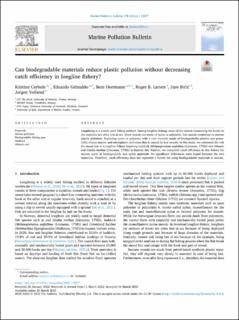Can biodegradable materials reduce plastic pollution without decreasing catch efficiency in longline fishery?
Cerbule, Kristine; Grimaldo, Eduardo; Herrmann, Bent; Larsen, Roger B.; Brčić, Jure; Vollstad, Jørgen
Peer reviewed, Journal article
Published version
Permanent lenke
https://hdl.handle.net/11250/3010321Utgivelsesdato
2022Metadata
Vis full innførselSamlinger
- Publikasjoner fra CRIStin - SINTEF Ocean [1386]
- SINTEF Ocean [1460]
Sammendrag
Longlining is a widely used fishing method. During longline fishing, some of the snoods connecting the hooks to the mainline are often lost at sea. Since snoods are made of nylon or polyester, lost snoods contribute to marine plastic pollution. Replacing nylon or polyester with a new material made of biodegradable plastics can potentially reduce macro- and microplastic pollution that is caused by lost snoods. In this study, we estimated the risk for snood loss in a longline fishery targeting haddock (Melanogrammus aeglefinus (Linnaeus, 1758)) and Atlantic cod (Gadus morhua (Linnaeus, 1758)) in Barents Sea. Further, we compared catch efficiency in this fishery for snoods made of biodegradable and nylon materials. No significant differences were found between the two materials. Therefore, catch efficiency does not represent a barrier for using biodegradable materials in snoods.

